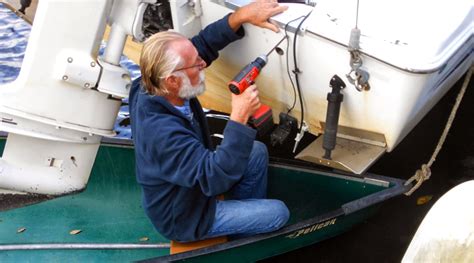How To Install Fish Finder On Aluminum Boat
Ronan Farrow
Apr 01, 2025 · 3 min read

Table of Contents
How to Install a Fish Finder on Your Aluminum Boat
Installing a fish finder on your aluminum boat might seem daunting, but with the right tools and a little patience, it's a manageable DIY project. This guide will walk you through the process, step-by-step, ensuring you have a clear picture of what's involved before you even pick up a wrench.
Choosing the Right Location for Your Fish Finder Transducer
The first and arguably most important step is selecting the optimal location for your transducer. This impacts the accuracy and reliability of your fish finder's readings. Consider these factors:
- Minimal Interference: Avoid areas with potential interference from the boat's motor, battery, or other electronic components. These can create false readings or disrupt the signal.
- Smooth Surface: A smooth, flat surface is crucial for a strong, consistent signal. Avoid areas with rivets, welds, or significant curvature. The transducer needs consistent contact with the water.
- Water Flow: The transducer needs to be submerged in water to function. Choose a location that ensures consistent water flow, even at low speeds.
- Easy Access: While you want a location that minimizes interference, you also want easy access for maintenance or potential repairs. Don't bury it somewhere inaccessible!
Gathering Your Tools and Materials
Before you begin, gather the necessary tools and materials. Having everything ready will make the process smoother and more efficient:
- Your Fish Finder: This is the star of the show! Make sure you have all the components, including the transducer, wiring, and mounting hardware.
- Drill: A cordless drill with various drill bits will be needed for mounting the transducer and running the wiring.
- Screwdriver: The type will depend on your fish finder's mounting hardware.
- Measuring Tape and Pencil: Essential for precise marking and measurement.
- Waterproof Sealant: This is crucial for preventing water intrusion and protecting your wiring.
- Wire Connectors: Use waterproof connectors to securely join wires and prevent corrosion.
- Cable Ties: Useful for organizing and securing wires.
- Safety Glasses: Always protect your eyes when working with power tools.
Mounting the Transducer
This is the most critical step in the installation process. Follow these steps carefully:
- Clean the Surface: Thoroughly clean the area where you plan to mount the transducer. Any dirt, grease, or debris could interfere with the bond.
- Mark the Mounting Location: Use your measuring tape and pencil to mark the exact location for the transducer. Double-check your measurements to ensure accuracy.
- Drill Pilot Holes: Carefully drill pilot holes to guide the mounting screws. This prevents the aluminum from cracking or tearing.
- Secure the Transducer: Mount the transducer using the provided hardware, ensuring it is firmly and securely attached.
- Seal the Mounting Area: Apply a generous layer of waterproof sealant around the base of the transducer to prevent water intrusion.
Running the Wiring
Routing the wiring neatly and securely is essential for both functionality and aesthetics.
- Plan Your Wiring Route: Carefully plan the route for the wiring, avoiding sharp bends, obstacles, and areas prone to abrasion.
- Secure the Wiring: Use cable ties to secure the wiring neatly along its route. This prevents the wires from becoming tangled or damaged.
- Connect the Wiring: Carefully connect the wiring to the fish finder unit, using waterproof connectors to ensure a secure and watertight connection.
Mounting the Fish Finder Head Unit
The final step is mounting the fish finder's head unit. This is typically done inside the boat for protection from the elements. Choose a location that provides a clear view of the screen and is convenient for operation while underway.
Important Considerations for Aluminum Boats
Aluminum boats present some unique considerations:
- Corrosion: Aluminum is susceptible to corrosion. Use marine-grade sealant and wiring to prevent corrosion and maintain the longevity of your system.
- Grounding: Proper grounding is vital in aluminum boats to prevent interference and electrical issues.
By following these steps, you can successfully install your fish finder on your aluminum boat. Remember to consult your fish finder's specific instructions for detailed guidance and safety precautions. Happy fishing!
Featured Posts
Also read the following articles
| Article Title | Date |
|---|---|
| How To Measure For A Pool Liner | Apr 01, 2025 |
| How To Make A Truck Tonneau Cover | Apr 01, 2025 |
| How To Make A Fall Tree | Apr 01, 2025 |
| How To Make A Gymnastics Routine | Apr 01, 2025 |
| How To Hang Bear Rug | Apr 01, 2025 |
Latest Posts
-
Guess How Many In The Jar Printable Free
Apr 03, 2025
-
Gripstic Bag Sealer How To Use
Apr 03, 2025
-
Gr20 Corsica How Many Days
Apr 03, 2025
-
Gordie Howe Jersey For Sale
Apr 03, 2025
-
Glass Pipe Screen How To Use
Apr 03, 2025
Thank you for visiting our website which covers about How To Install Fish Finder On Aluminum Boat . We hope the information provided has been useful to you. Feel free to contact us if you have any questions or need further assistance. See you next time and don't miss to bookmark.
